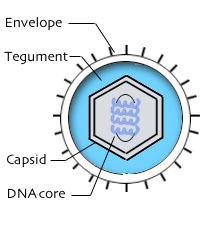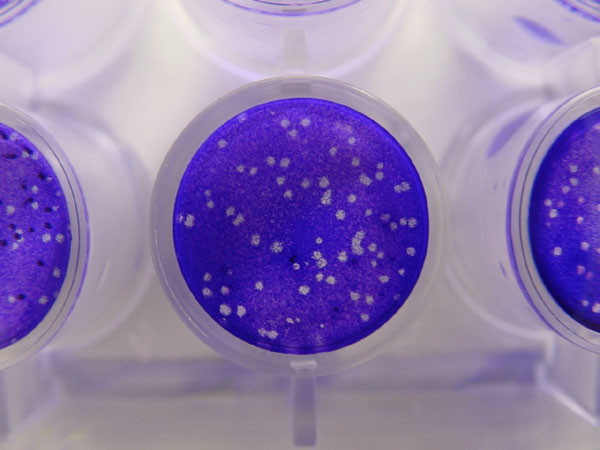Herpesviridae
There are many types of viruses grouped under herpesviridae and can be categorised into Alpha, Beta and Gamma herpes. In this blog entry Herpes Simplex 1 and Herpes Simplex 2 viruses under the alpha herpes category, the cytomegalovirus under the Beta herpes category and the Epstein Barr Virus under the gamma herpes category will be discussed.
The diagram below shows the different categories of viruses. However, not all herpes viruses are shown below.
(click image to enlarge)
Features of Herpesviridae Viruses
The unique feature of the herpesviridae viruses’ properties is its ability to stay latent after primary infection and reactivate due to certain factors (stress, menstruation, long exposure to sunlight). After primary infection it stays latent in the nerves cells of the host.
One unique structural feature is its concentric virion which consists of:
· Inner core
· Icosahedral capsid
· Amphorous tegument
· Glycoprotein envelope
· Linear double stranded DNA
Herpes Simplex 1 Virus
The herpes simplex 1 virus causes cold sores and blisters which can affect the mouth, eyes and gums. After primary infection, the virus stays latent in the nerves cells of the host where it can avoid destruction by immune cells until certain factors (stress, menstruation, long exposure to sunlight) reactivates the virus. This reactivated virus causes symptoms such as cold sores.
Almost all of the adult population has contracted the Herpes Simplex 1 virus through kissing and close proximity to one another. Hence to prevent contracting this, avoid kissing and close proximity to people you do not know. However this virus is not life threatening so it is not much of a threat to public health.
Herpes Simplex 2 Virus
The herpes simplex 2 virus or genital herpes virus causes blisters and burning sensations at the genitals. A foul smelling discharge will be produced from 1 to 3 weeks of the infection.
In the United States about 20% of the adult population has contracted the herpes simplex 2 virus. Since this virus is spread through sexual contact, the most effective method to prevent contracting it is to stop any risky sexual behaviour.
Varicella Zoster Virus
The Varicella Zoster Virus causes 2 types of infections when it infects a host. During the initial infection, it causes chicken pox. After the chicken pox has been cured, it stays latent in the nerve tissues to avoid destruction by immune cells until the efficiency of the immune system dimishes (mostly due to old age) causing reactivation. In this reactivation the symptoms manifests itself in the form of shingles.
The symptoms for the primary infection (chicken pox) are shown below:
· Fever
· Lesion on the body
· Scaring
· Can cause damage to the foetus in pregnant women
· Can be passed from mother to child in pregnant women.
· May cause Guillain Barre syndrome
In the secondary infection which occurs due to virus reactivation shingles on the body will form.
Varicella zoster virus infections can be prevented by administering a vaccine which is available and avoiding infected people.
Varicella zoster virus infections can be prevented by administering a vaccine which is available and avoiding infected people.
Epstein Barr Virus
This virus affects the nasopharynx pathways and salivary gland and causes the following symptoms:
· Sore throat lasting a few weeks
· Swollen lymph nodes
· Persistent fever
· Fatigue
The Epstein Barr Virus also plays a part in the emergence of 2 types of cancer which are Burkitt’s lymphoma and nasopharyngeal carcinoma.
Cytomegalovirus
The cytomegalovirus is a virus that causes asymptomatic infection in otherwise healthy individuals. In immunocompromised hosts, the viruses causes eye, brain, intestinal and respiratory infections. In newborns it can cause asymptomatic infection to acute symptoms such as fever, brain damage and even death. In adults it can also cause acute symptoms similar to the Epstein Barr Virus.
To prevent contracting the cytomegalovirus, avoid infected persons and avoid blood and bodily fluid contact.
Lab Diagnosis
Diagnosis can be done use blood test, virus cultures and antigen testing to detect the herpes viruses.
Videos
This video shows what happens when varicella zoster virus re-activates after a person has suffered from chicken pox.
References
Pictures:
- http://stdgen.northwestern.edu/stdgen/bacteria/hhv2/herpes.diagram.jpg
- http://z.about.com/d/dermatology/1/0/J/5/HerpLip.jpg
- http://www.hfreedomnetwork.org/pb/wp_a6802eba/images/img1375543abab7c86d3e.jpg
- http://www.childhoodhealth.com/images/varicella_large.jpg
- http://medicalimages.allrefer.com/large/chicken-pox.jpg
- http://microvet.arizona.edu/Courses/MIC419/ToolBox/elisa3.jpg
- http://upload.wikimedia.org/wikipedia/commons/7/76/Plaque_assay_macro.jpg
Information:
HELLO
5:01 PM
5:01 PM









